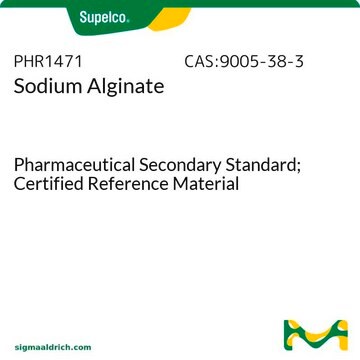If this product has an expiration or retest date, it will be shown on the Certificate of Analysis (COA, CofA). If there is no retest or expiration date listed on the product's COA, we do not have suitable stability data to determine a shelf life. For these products, the only date on the COA will be the release date; a retest, expiration, or use-by-date will not be displayed.
For all products, we recommend handling per defined conditions as printed in our product literature and website product descriptions. We recommend that products should be routinely inspected by customers to ensure they perform as expected.
For products without retest or expiration dates, our standard warranty of 1 year from the date of shipment is applicable.
For more information, please refer to the Product Dating Information document: https://www.sigmaaldrich.com/deepweb/assets/sigmaaldrich/marketing/global/documents/449/386/product-dating-information-mk.pdf
71238
Alginic acid sodium salt from brown algae
BioReagent, suitable for immobilization of micro-organisms
Synonyme(s) :
Algin, Sodium alginate
Sélectionner une taille de conditionnement
Sélectionner une taille de conditionnement
About This Item
Produits recommandés
Source biologique
algae (brown)
Gamme de produits
BioReagent
Forme
powder
Résidus de calcination
≤30%
Perte
≤15% loss on drying
Couleur
white to light beige
pH
6.0-8.0 (10 mg/mL in H2O)
Adéquation
in accordance for gelation test
suitable for immobilization of micro-organisms
Température de stockage
room temp
Chaîne SMILES
[Na+].[O-]C(=O)C1O[C@H]([C@H]([C@H]([C@@H]1O)O)O)O
InChI
1S/C6H10O7.Na/c7-1-2(8)4(5(10)11)13-6(12)3(1)9;/h1-4,6-9,12H,(H,10,11);/q;+1/p-1/t1-,2-,3-,4?,6+;/m0./s1
Clé InChI
MSXHSNHNTORCAW-MPGIDXPLSA-M
Vous recherchez des produits similaires ? Visite Guide de comparaison des produits
Application
Autres remarques
Code de la classe de stockage
11 - Combustible Solids
Classe de danger pour l'eau (WGK)
WGK 1
Point d'éclair (°F)
Not applicable
Point d'éclair (°C)
Not applicable
Équipement de protection individuelle
Eyeshields, Gloves, type N95 (US)
Faites votre choix parmi les versions les plus récentes :
Déjà en possession de ce produit ?
Retrouvez la documentation relative aux produits que vous avez récemment achetés dans la Bibliothèque de documents.
-
How can I determine the shelf life / expiration / retest date of this product?
1 réponse-
Utile ?
-
-
How is shipping temperature determined? And how is it related to the product storage temperature?
1 réponse-
Products may be shipped at a different temperature than the recommended long-term storage temperature. If the product quality is sensitive to short-term exposure to conditions other than the recommended long-term storage, it will be shipped on wet or dry-ice. If the product quality is NOT affected by short-term exposure to conditions other than the recommended long-term storage, it will be shipped at ambient temperature. As shipping routes are configured for minimum transit times, shipping at ambient temperature helps control shipping costs for our customers. For more information, please refer to the Storage and Transport Conditions document: https://www.sigmaaldrich.com/deepweb/assets/sigmaaldrich/marketing/global/documents/316/622/storage-transport-conditions-mk.pdf
Utile ?
-
-
What is the viscosity of the alginate?
1 réponse-
The viscosity is not determined for this product on a lot specific basis. However, the viscosity is generally between 100 - 200 mPa sec for a 1% solution at 20°C. Please note that the viscosity is not a listed test specification and has not been validated.
Utile ?
-
-
What is the viscosity of this product?
1 réponse-
The viscosity of product is not tested on a lot specific basis, however historical values indicate a range of 100 - 200 cP at 1% in water, 20 °C.
Utile ?
-
-
WHAT IS THE MANNURONIC ACID TO GULURONIC ACID (M/G) RATIO OF THIS PRODUCT (71238)?
1 réponse-
The guluronic acid content in this product is approximately 70 % and the mannuronic acid content is approximately 30 %
Utile ?
-
-
What is the average molecular weight?
1 réponse-
The molecular weight is approx. 100,000 - 200,000 g/moL.
Utile ?
-
Filtres actifs
Notre équipe de scientifiques dispose d'une expérience dans tous les secteurs de la recherche, notamment en sciences de la vie, science des matériaux, synthèse chimique, chromatographie, analyse et dans de nombreux autres domaines..
Contacter notre Service technique






